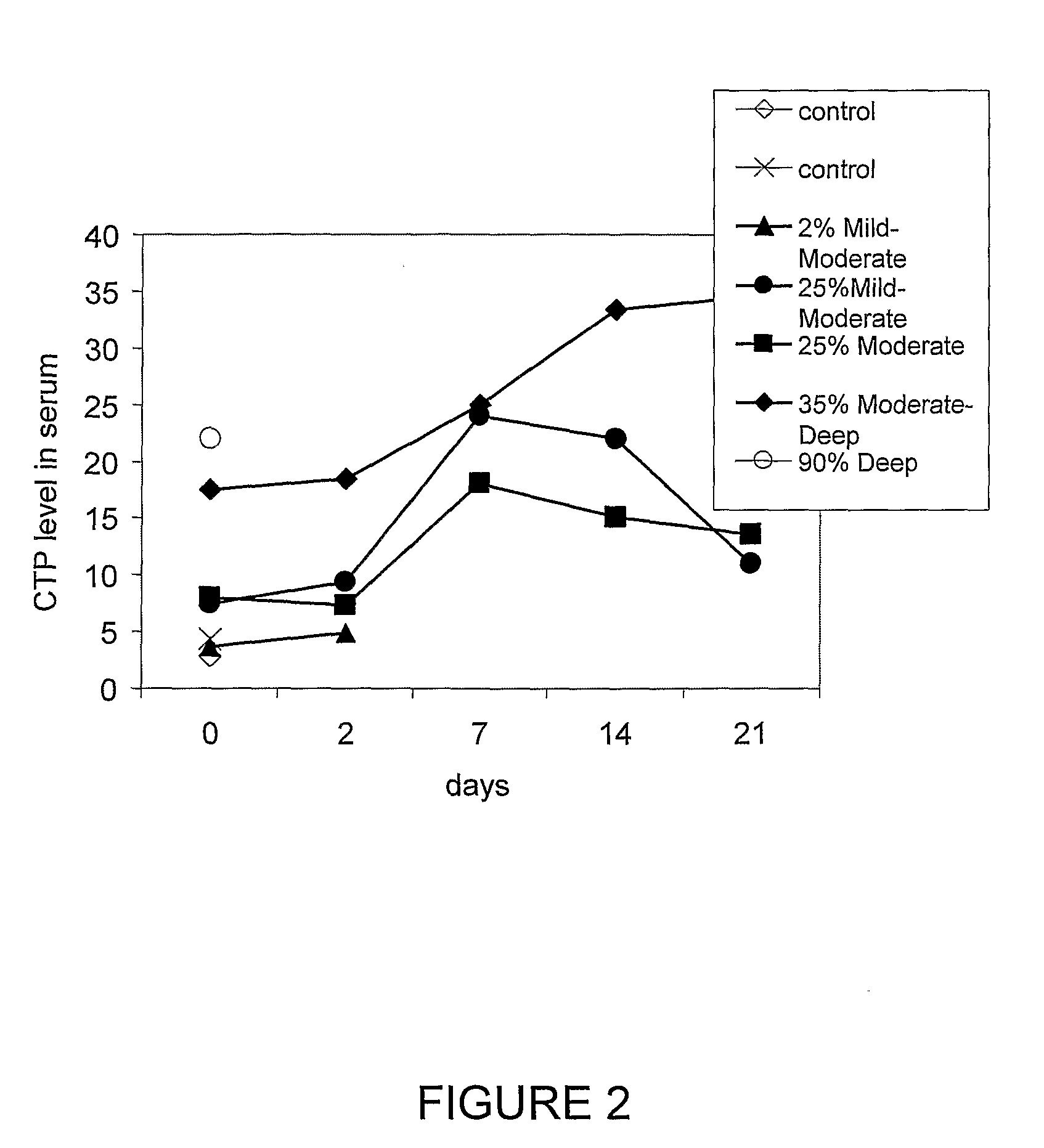Monitoring skin metabolism products for evaluating burn injury
a technology of skin metabolism and products, applied in the direction of disease diagnosis, material testing goods, instruments, etc., can solve the problems of only affecting the epidermis, redness of the skin, damage to the cells of living tissue, etc., and achieve the effect of accurate evaluation of severity, rapid and cost-effectiv
- Summary
- Abstract
- Description
- Claims
- Application Information
AI Technical Summary
Benefits of technology
Problems solved by technology
Method used
Image
Examples
example 1
C-telopeptide Concentration in Control and Post-Burn samples
[0169]A guinea pig model of burn injury is used. The animals are exposed to heat trauma using the following protocol: A guinea pig is shaved (electrical shaver) twenty-four hours prior the experiment. After shaving, the animal is anesthetized by 15-30 mg / kg pentobarbital i.p., placed in insulating fixed area shield, dorsum exposed, and immersed in a water bath of 80° C. for 30 sec. This produces a full-thickness burn, of about 25% of body surface area. Animal are then immediately resuscitated post-burn with 3 ml i.p. of sterile normal saline.
[0170]Blood samples are obtained from the anesthetized animals before the exposure to heat (time 0, control) and at 15, 30, 60 and 120 min post-burn. At least four samples for each time point are taken. Concentration of C-telopeptide is assessed using radio-immunoassay and anti-C-telopeptide antibody (Orion Diagnostica (Espoo, Finland). This model shows that the CTP concentration in a b...
example 2
Use of the Concentration of CTP-I in Blood Samples for Assessment of Burn Injury Severity
[0171]This preliminary study included 5 burn patients, each of which had a differing degree of burn severity and percentage of body area affected as follows: patient 1: mild, 2% body area; patient 2: mild-moderate, 25% body area; patient 3: moderate, 25% body area; patient 4: moderate-deep, 35% body area , and patient 5: deep, 90% body area). Four healthy individuals served as a control group. Blood samples were taken from patients on arrival to the hospital emergency room, or within 3 hours of arrival. CTP-I serum levels were measured using ELISA and anti-C-telopeptide antibody (UniQ). As shown in FIG. 1, the CTP-I levels of patients 1-5 were respectively 4.8 (empty bars); 6.95 (horizontally striped bars); 8.02 (diagonally striped bars); 18.48 (stippled bars); and 23.49 (vertically striped bars) ng per L, respectively. The CTP-I levels of the control group (black bars) were: 2.85, 4.42, 3.74, a...
example 3
Measuring Dynamics of CTP-I Serum Levels for Monitoring of Burn Patients
[0173]The patients described in Example 2 were continually monitored at periodic intervals (corresponding to 2, 7, 14 and 21 days following burn injury) for CTP-I levels in blood. The results, shown in FIG. 2, indicate that in some patients, the level of CTP-I declined as the burn injury healing process proceeded.
[0174]The foregoing description of the specific embodiments will so fully reveal the general nature of the invention that others can, by applying current knowledge, readily modify and / or adapt for various applications such specific embodiments without undue experimentation and without departing from the generic concept, and, therefore, such adaptations and modifications should and are intended to be comprehended within the meaning and range of equivalents of the disclosed embodiments. It is to be understood that the phraseology or terminology employed herein is for the purpose of description and not of ...
PUM
| Property | Measurement | Unit |
|---|---|---|
| Time | aaaaa | aaaaa |
| Time | aaaaa | aaaaa |
| Time | aaaaa | aaaaa |
Abstract
Description
Claims
Application Information
 Login to View More
Login to View More - Generate Ideas
- Intellectual Property
- Life Sciences
- Materials
- Tech Scout
- Unparalleled Data Quality
- Higher Quality Content
- 60% Fewer Hallucinations
Browse by: Latest US Patents, China's latest patents, Technical Efficacy Thesaurus, Application Domain, Technology Topic, Popular Technical Reports.
© 2025 PatSnap. All rights reserved.Legal|Privacy policy|Modern Slavery Act Transparency Statement|Sitemap|About US| Contact US: help@patsnap.com


